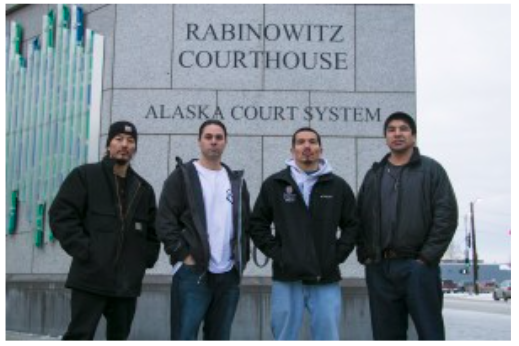FAIRBANKS MEN WERE FREED, BUT INNOCENCE NOT YET ESTABLISHED
Alaskans still don’t have a clear idea of who killed 15-year-old John Hartman in October of 1997. But it’s apparent that the four men who served time for the 1997 beating death, and who are now suing the City of Fairbanks, were released due to political pressure on the governor, not necessarily because of their innocence.
The four — George Frese, 20; Kevin Pease, 18; Marvin Roberts, 19; and Eugene Vent, 17, were marketed by their attorneys and supporters as the “Fairbanks Four.” The name stuck.
The idea of applying a catchy name worked well for the Chicago Seven in the 1960s, and it is a winning strategy for those who want to demonstrate that an injustice has occurred.
Their case became a cause celebre for Native Americans, journalists, and journalism and law students. A web site was launched to exonerate them. But even though their attorneys make claims to the contrary, they have never actually been truly exonerated.
Through the legal process, they had been found guilty. But in the court of Alaska politics, they became victims, rather than perpetrators.
In the end, the Walker Administration just could not take the pressure — it washed its hands of the matter and let them go, under the condition they would not sue.

John Hartman’s death occurred Oct. 12, 1997, about 24 hours after he had been found beaten on the street.
In a jury trial, Roberts was found guilty of Murder 1, Murder 2, 1st degree robbery, and assault in the second degree in connection to the death of John Hartman. He had been the driver of the car, as implicated by Vent. Vent and Frese admitted to the crime.
Today, Roberts is suing. His attorneys say he was framed. The other three men followed suit.
The case had political and racial elements from the beginning and the Tanana Chiefs Conference, which is close to the courthouse, kept the cause alive.
Then, soon after Gov. Bill Walker was elected, a deal was struck. The Department of Law, with Attorney General Craig Richards, worked a way out of the political problem: They worded a release deal carefully, so that the state did not admit to any wrongful judgment against the four, but stipulated that the “original jury verdicts and judgments of conviction were properly and validly entered based on proof beyond a reasonable doubt.”
Roberts signed it.
What AG Richards said was more guarded: “In this settlement, the four defendants agreed they were properly and validly investigated, prosecuted and convicted. This compromise reflects the attorney general’s recognition that if the defendants were retried today it is not clear under the current state of the evidence that they would be convicted.
On page 3 on “Robert’s Settlement Agreement and Mutual Release of all Claims,” Roberts agreed that the City of Fairbanks and its departments, divisions, agencies, agents, representatives, directors, past and current employees, attorneys, contractors, retained or non-retained experts, witnesses, predecessors or successors in interest were released and forever discharged.
That means he would not sue the City of Fairbanks either. But that was then.
Roberts is now saying he was coerced into signing the Attorney General’s release. He was already out on parole at the time of the settlement, but the other three would not be released from prison until he signed the agreement, and he now says that the pressure to do so was too much for him. He did it against his will.
IT BECAME PART OF THE 2014 ELECTION CYCLE
Did Gov. Walker cave under the tremendous racial/political pressure from a core constituency that helped elect him?
At Alaska Federation of Natives convention in 2015, Walker faced a convention full of people who were raising four fingers in the air, to demand the release of the four men.
Sen. Mark Begich asked for federal intervention in 2014, formally requesting a review from the Civil Rights Division of the U.S. Department of Justice and saying that there had been “prosecutorial misconduct and coercion, along with evidence uncovered in recent years that includes a confession to the crime by a different individual.”
“It is time for a thorough review of the circumstances of this case by an impartial authority,” said Begich. “The State has requested delay after delay of its review and has attempted to keep information from being publicly disclosed. I agree with the Alaska Federation of Natives and the Tanana Chiefs Conference that this case requires federal review, and that is why I’ve made the formal request of the DOJ. We must be certain that those who are guilty of the brutal murder of John Hartman in 1997 have been brought to justice.”
In September of 2013, a Fairbanks man serving a double-life sentence in California claimed that he and some friends from Lathrop High School killed Hartman. It’s a complicating factor, to be sure. William Holmes, Jason Wallace, Shelmar Johnson, Rashad Brown, and Marquez Pennington are the real culprits, according to the attorney for the Fairbanks Four, Michael Kramer.
THE CONFESSIONS OF TWO OF THE FAIRBANKS FOUR
The problem with the lawsuit filed by the four men against the City of Fairbanks is that there is still are the confessions, such as this one from George Frese to law enforcement on Oct. 11, 1997, parts of which are highlighted here. Frese was 20 at the time he made these statements.
It’s unlikely that Alaskans, who have followed the case through newspaper accounts, have ever seen these documents, but the people of Fairbanks would be interested in them, since it’s the people of Fairbanks who are now being sued by the four men, who say their civil rights were violated. These documents are excerpts of an extended interview:
CONFESSION OF GEORGE FRESE:







They killed him without a doubt and now they get paid for it!
Again Suzanne great job with the truth. Thank You
Any money these clowns MIGHT get should go to the Hartman family, PERIOD.
so what is the payoff for anyone else to commit a heinous crime? what is these four mens future? will they understand the payoff for this behavior and what will deter any of them in the future?why does anyone in society support this behavior?
Now we have murder being rewarded and the law is mocked. No fear of breaking the law, no respect for innocent people who are just walking down the street. No safe place for law abiding citizens to live their lives in public places. Drunk behavior
and not remembering what you are doing is no excuse for wanting to leap out of a car and kick someone to death. What motivates someone to be so jealous of a nice young man????? No apology, just pay me for my drunken rage.
Remember this next November when you cast your vote for Governor!
If you read the full interrogation transcripts, which UAF Journalism first published in 2004, you will find all the facts of the case first surface in questions from the FPD detectives. This is a hallmark of false confessions exposed through DNA testing. Despite being arrested the same weekend of John Hartman’s fatal beating, police found no physical evidence linking any of the men accused to the victim. The case rested on bungled interrogations of drunken youths, snitch testimony and IDs by a witness, also drunk, standing 540-away from an unrelated assault. UAF students and I documented all of this in “Decade of Doubt,” a 2008 News-Miner series. Cops & courts got this wrong, the 4 spent 18 years incarcerated on charges erased from the books. The truth, long concealed under attorney client privilege, emerged during Gov. Sean Parnel’s tenure as governor. It’s shameful Alaska officials responded with a coverup.
“Despite being arrested the same weekend of John Hartman’s fatal beating, police found no physical evidence linking any of the men accused to the victim.”
How can that be so?
– Julie Klaker, Hartman’s primary nurse, compared Frese’s boot to the tread marks on Hartman’s facial bruises. “They matched up perfectly, actually,” according to her testimony.
– What about the gum at the crime scene? Vent told Detective Ring that “I might have given him gum.” At that point, Detective Ring hadn’t said anything about finding gum around the scene where Hartman was beaten.
Thanks, Brian. Exactly what I was thinking.
I know two lawyers and two investigators on that case. You need to realize that defense lawyers are usually quite cynical. Clients do not always tell them the truth. Police frequently let their pre-judgments cloud how they view evidence and prosecutors’ view of exculpatory evidence is not the same as the defense attorneys. Indeed, many defense attorneys would rather represent guilty people than innocent people because so many jurors start with the idea of “What did this guy do to be here?” At the end of the day, when you’ve fought as hard as you can, it is far easier to accept a guilty verdict if the client is indeed guilty. Seeing someone you believe to be innocent be convicted is one of the hardest parts of the job. And anybody with the guts to actually take cases to trial has seen innocent people convicted.
So it was quite striking when I heard the lawyers and investigators say that they are 100% convinced that their client did not commit the murder. That statement is not made about many cases. The confessions were tainted by long interrogations and coercive interview techniques. In fact, false confessions are the leading cause of wrongful convictions. Further, as I understand the evidence, the confessions did not match the physical evidence at the scene, another indication that the confessions were false. Everyone I know involved in this case said that the cops focused on the wrong people. There are not many cases in which I have seen attorneys and/or investigators so vehement about their client’s innocence. That does not mean they are right but it is food for thought.
I will be the first to admit that I did not try the case and I only know what was published. The hearing for a new trial, though, demonstrated some serious holes in the prosecution’s case. If all of that evidence had been available would there have been a different outcome? Hard to say. High profile cases take on a life of their own and juries are well aware of what the community expects in those cases. I think it is highly significant that the State did not await the judge’s decision but resolved the case after the close of evidence. I understand the defendants settling the case to get out of jail but if the State thought they had a really good case to uphold the initial jury decision, they could easily have waited the few months until the judge issued a decision. That the State chose to settle immediately says that the State recognized the weakness in their case and rather than take the chance at an order for a new trial, if not a merits decision with prejudice, they got what they could and ran.
So they don’t like the deal Walker gave them. Lock them back up and let them sue from jail.
Craig Richards. AG for Walker. General Counsel for Bering Strait Native Corporation. Now he is going to be making more deals with the Permanent Fund.
He is not done yet. Thanks Governor.
guilty as hell
Is this what the Tribe wants as part of their legacy? Young Native men getting drunk and kicking a young boy to death. When the victim died and these four boys were caught, confessed, then tried and convicted
who would’ve ever thought this would be the final outcome. Very disturbing!